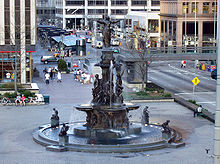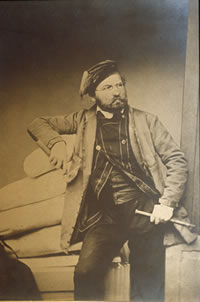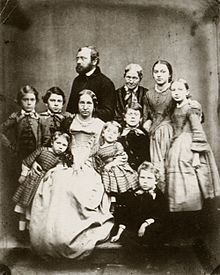Ferdinand von Miller
Ferdinand Miller , from 1851 Ritter von Miller (born October 18, 1813 in Fürstenfeldbruck , † February 11, 1887 in Munich ) was a Bavarian ore caster and created the Bavaria statue as inspector of the royal ore foundry in Munich . He was a co-founder of the Bavarian Arts and Crafts Association , from 1869 a member of the Bavarian State Parliament and from 1874 a member of the German Reichstag .
family
Miller came from a Upper Bavarian family from Aichach . His parents were Joseph Anton Miller and Julie Stiglmaier, the sister of Johann Baptist Stiglmaier , the first inspector of the royal ore foundry in Munich.
In 1840 he married Anna Pösl (1815–1890), the daughter of the Landshut government chancellor, with whom he had 14 children. Among his children are the sculptor, ore caster and director of the Royal Art Academy in Munich , Ferdinand Freiherr von Miller (1842–1929), the electrical engineer and founder of the Deutsches Museum Oskar von Miller (1855–1934), the sculptor Fritz von Miller (1840–1921) ) and the professor of chemistry Wilhelm von Miller (1848–1899).
Life
Miller initially worked in the Royal Ore Foundry under his uncle as a laborer. Stiglmaier quickly recognized his nephew's talent and enabled the gifted boy to visit the Royal Academy of Fine Arts in Munich and the Art Academy in Paris , where he made the acquaintance of Alexander von Humboldt . He told him about a new project by King Ludwig I , in which a larger than life figure, the " Bavaria ", was to be cast. Miller returned to Munich, took over the royal ore foundry as the first inspector to succeed his uncle and from then on worked on the “Bavaria” project. It took him eight years for the figure's 15-meter-high head and processed 87,360 kg of ore . The gigantic work was finally unveiled in 1850. In 1863 Ferdinand von Miller went blind in one eye due to retinal detachment . In 1878 he acquired the ore foundry from the Bavarian state.
tomb
The tomb of Ferdinand Miller is on the old southern cemetery in Munich (wall right place 79/80 at cemetery 4) Location . The tomb was designed by Leonhard Romeis . The incorporated bronzes are from Ferdinand Müller's son Ferdinand Miller the Elder. J. designed and cast. The large relief shows Mary with the baby Jesus, Ferdinand von Miller with his sons Fritz, Ferdinand, Wilhelm are shown to the left of the base. Ludwig, Alfons, Christoph, Winfried and Oskar. To the right of the plinth are his wife Anna and their daughters Anna and Julie. Miller's children, who died early, are depicted as angel figures in the middle of the plinth.
Honors
In recognition of his services, Miller was awarded the Order of Merit of the Bavarian Crown on January 1, 1851 after the completion of the "Bavaria" and was elevated to the Bavarian personal nobility as a knight of Miller due to the statutes of the order . On 12 October 1875 he also received the Bavarian hereditary nobility and was on 30 December 1875 in the Adelsmatrikel of the Kingdom of Bavaria in the noble class enrolled. His bust was displayed in the Hall of Fame in Munich. He was a member of the Munich Association for Christian Art . In Fürstenfeldbruck (Upper Bavaria) a secondary school was named after him; In memory of the house where he was born, a plaque in relief was created - probably in 1936 - (Hauptstrasse 15). In 1876 he received the Golden Citizen Medal of the City of Munich . In 1909 he was made an honorary member of the Dresden Art Academy .

List of public monuments produced by Ferdinand von Miller
- Bad Brückenau Staatsbad Brückenau : Monument to King Ludwig I.
- Bad Tölz : Kaspar III. Vintner , monument in Marktstrasse
- Bamberg : Maximiliansbrunnen 1880
- Berlin: equestrian statue of Emperor Friedrich III., Museum Island , in front of the Kaiser-Friedrich-Museum
- Breslau : equestrian statue of Kaiser Wilhelm I, next to the Corpus Christi Church
- Dinkelsbühl : Monument to the youth writer Christoph von Schmid (design by Max von Widnmann )
- Dortmund : War memorial 1870/71 on Hiltropwall
- Dresden : Warrior and Victory Monument 1871, on the Altmarkt
- Ehingen : Kaiser Wilhelm I bust in the Kaiser Wilhelm Memorial Tower on Wolfert
- Elbing : District war memorial 1870/71
- Frankfurt am Main : Goethe statue on Goetheplatz
- Friedrichshafen : bust for the Kaiser Wilhelm I monument in the city park
- Landshut : Monument to Duke Ludwig the Rich based on a design by Friedrich Brugger
- Mannheim : Schiller Monument (1862), on Schillerplatz, and August Wilhelm Iffland statue (1864), formerly on Schillerplatz, destroyed by bombs in World War II
- Metz : equestrian statue of Kaiser Wilhelm I (1889–1892) on the esplanade
- Munich : Schiller monument on Maximiliansplatz
- Munich : War memorial 1870/71 in the Feldherrnhalle , Odeonsplatz
- Neunkirchen (Saar) : Kaiser Wilhelm I statue on the market square
- Neustadt an der Weinstrasse : Germania monument, Karolinenstrasse
- Nuremberg : Prince Regent Luitpold equestrian statue in front of the station building
- Rheydt -Geneiken: Kaiser Wilhelm I bust monument on Kaiserplatz
- Rüdesheim am Rhein : Germania statue on the Niederwald monument
- St. Louis, USA: Alexander von Humboldt statue in the Botanical Garden
- Stuttgart-Bad Cannstatt : equestrian statue of King Wilhelm I of Württemberg
- Stuttgart : Allegorical figures of art, science, trade and the military stand on the anniversary column on the Schlossplatz
- Trier : Kaiser Wilhelm I statue on the Domfreihof
- Trier : Baldwin Fountain: bronze statue of the Trier Elector and Archbishop Baldwin of Luxembourg
- Weimar : Johann Gottfried von Herder statue on Herderplatz
- Würzburg : Frankonia Fountain
World exhibition
Miller also made the Quadriga for the Munich Siegestor . When he heard about the 1st World Exhibition (1851) in London, the idea occurred to him to present one of the lions there. The transport posed a great financial and logistical challenge. The effort paid off, however: the ore caster from Munich won first prize and was able to use the international attention it had gained to win orders from all over the world.
Ferdinand von Miller with his sons Fritz and Ferdinand loading the lion for the Great Exhibition in London (1851)
Other work

Miller's work soon achieved world fame. His works were also known in America and it was not long before the sculptor Thomas Crawford sent his designs to Munich. For example, Miller made a 22-foot tall equestrian model of George Washington .
Miller's other work also includes gates for the Capitol in Washington, DC , an equestrian statue for the government in Colombia, and the Goethe-Schiller monument in Weimar .
Another cast by Miller is the Schiller statue, modeled by the Munich sculptor Maximilian von Widnmann, which has stood in Schillerpark in Columbus / Ohio / USA since 1891.
literature
- Hyacinth Holland : Miller, Ferdinand von . In: Allgemeine Deutsche Biographie (ADB). Volume 52, Duncker & Humblot, Leipzig 1906, pp. 401-409.
- Peter Volk : Miller, Ferdinand von. In: New German Biography (NDB). Volume 17, Duncker & Humblot, Berlin 1994, ISBN 3-428-00198-2 , p. 516 f. ( Digitized version ).
- Genealogical manual of the nobility . Nobility Lexicon. Volume IX, Volume 116 of the complete series, CA Starke Verlag, Limburg (Lahn) 1998, ISSN 0435-2408 .
- Angelika Mundorff, Eva von Seckendorff (Ed.): The Millers - Aufbruch einer Familie. Allitera Verlag, Munich 2006. ISBN 3-86520-187-3 .
Web links
- Literature by and about Ferdinand von Miller in the catalog of the German National Library
- Ferdinand von Miller in the parliamentary database at the House of Bavarian History
- Ferdinand von Miller in the database of members of the Reichstag
- Biography of Ferdinand von Miller . In: Heinrich Best : database of the members of the Reichstag of the Empire 1867/71 to 1918 (Biorab - Kaiserreich)
- Deutsches Museum ( Memento from October 22, 1999 in the Internet Archive )
- The Tyler Davidson Fountain Restoration Project
Individual evidence
- ^ Wilhelm Füssl: Oskar von Miller 1855-1934. CH Beck, 2005, ISBN 3-406-52900-3 , p. 26 ( digitized version ).
- ^ Association for Christian Art in Munich (ed.): Festgabe in memory of the 50th year. Anniversary. Lentner'sche Hofbuchhandlung, Munich 1910, p. 101.
- ^ Archive of the Dresden University of Fine Arts.
- ↑ The unveiling ceremony for the monument to the young writer Christoph von Schmid zu Dinkelsbühl on October 12, 1859 . Bavarian State Library, Munich. Retrieved December 30, 2010.
- ^ August Wilhelm Iffland statue, Mannheim, 1864. In: senger-stiftung.de. Retrieved September 5, 2018.
- ^ Matschoß, Conrad: Ferdinand von Miller, der Erzgießer, 1913, p. 202 f.
- ↑ Seckendorff, Eva von; Munddorff, Angelika: Die Millers, 2006, p. 6.
| personal data | |
|---|---|
| SURNAME | Miller, Ferdinand von |
| ALTERNATIVE NAMES | Miller, Ferdinand; Miller, Ferdinand Ritter von |
| BRIEF DESCRIPTION | German ore caster, builder of Bavaria and politician (center), MdR |
| DATE OF BIRTH | October 18, 1813 |
| PLACE OF BIRTH | Fürstenfeldbruck |
| DATE OF DEATH | February 11, 1887 |
| Place of death | Munich |









